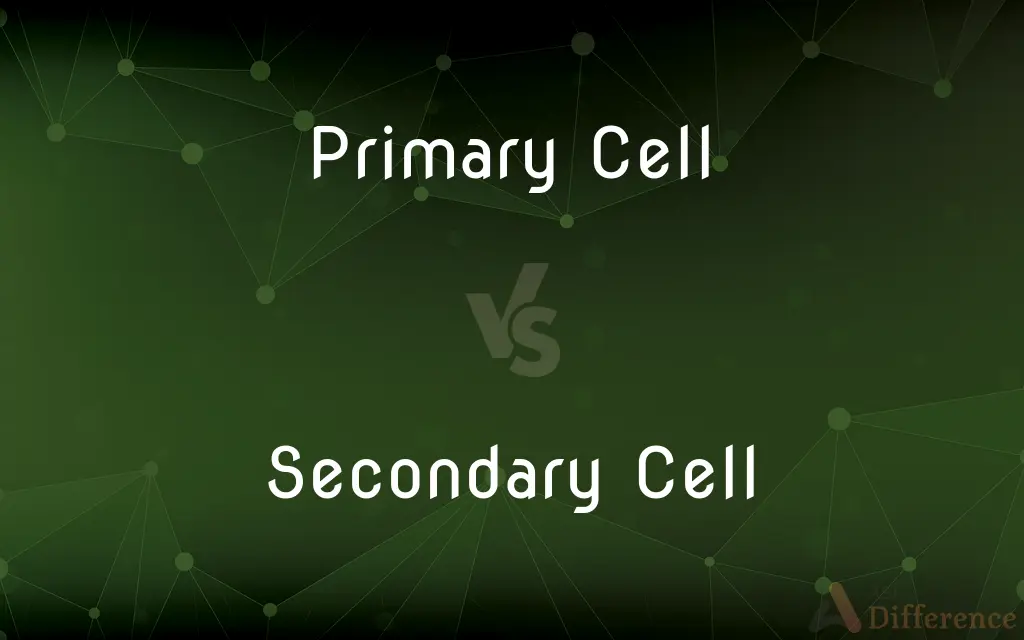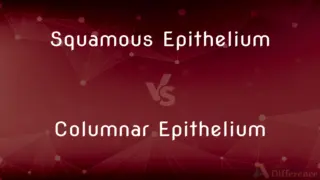Primary Cell vs. Secondary Cell — What's the Difference?
By Tayyaba Rehman — Published on January 13, 2024
Primary cells are single-use, non-rechargeable batteries, while secondary cells are rechargeable batteries that can be used multiple times.

Difference Between Primary Cell and Secondary Cell
Table of Contents
ADVERTISEMENT
Key Differences
Primary cells, or primary batteries, are designed for one-time use until they are depleted. They cannot be recharged once the energy stored in them is exhausted. In contrast, secondary cells, also known as secondary batteries or rechargeable batteries, are designed to be recharged and used multiple times. The chemical reactions in secondary cells are reversible, allowing them to restore their charge.
In terms of construction, primary cells often use a simple and cost-effective design suitable for devices with lower power requirements or devices used infrequently. Secondary cells, however, have more complex designs that enable them to undergo multiple charge-discharge cycles. This complexity often makes them more expensive initially than primary cells.
The chemical composition of primary cells varies, with common types including alkaline batteries and lithium batteries. Secondary cells also have a diverse range, including lead-acid, nickel-cadmium (NiCd), nickel-metal hydride (NiMH), and lithium-ion batteries. The choice between the two depends on factors like required lifespan, cost, and environmental considerations.
From an environmental perspective, primary cells, though convenient, can contribute to waste due to their disposability. Secondary cells are generally more environmentally friendly in the long term, as they reduce waste by being rechargeable, but they require proper disposal or recycling due to the toxic materials they may contain.
Applications for primary cells include low-drain devices like remote controls, flashlights, and smoke detectors. Secondary cells are used in high-drain applications like smartphones, laptops, and electric vehicles, where their rechargeability offers greater convenience and efficiency.
ADVERTISEMENT
Comparison Chart
Rechargeability
Non-rechargeable
Rechargeable
Design
Simple, cost-effective
More complex, higher initial cost
Chemical Composition
Alkaline, lithium, etc.
Lead-acid, NiCd, NiMH, lithium-ion
Environmental Impact
Higher waste due to disposability
Reduced waste, but requires proper disposal
Typical Applications
Low-drain devices
High-drain devices, electronic gadgets
Compare with Definitions
Primary Cell
One-time Use Battery: Designed for single use.
The primary cells in my flashlight need to be replaced.
Secondary Cell
Diverse Chemistries: Include various types like NiMH and lithium-ion.
Many portable electronics use lithium-ion secondary cells.
Primary Cell
Simple Design: Often have a simpler construction.
Primary cells are commonly used in remote controls due to their simple design.
Secondary Cell
High-Drain Applications: Common in devices requiring more power.
Laptops typically use secondary cells for better performance.
Primary Cell
Non-rechargeable: Cannot be recharged once depleted.
Alkaline batteries are primary cells and are disposed of after use.
Secondary Cell
Environmentally Friendly: Reduced waste due to rechargeability.
Using secondary cells in gadgets reduces environmental waste.
Primary Cell
Various Chemical Types: Made with different chemistries.
Lithium primary cells provide a longer lifespan for certain devices.
Secondary Cell
Complex Design: Feature a more complex construction.
Secondary cells in electric cars are complex but efficient.
Primary Cell
Ideal for Low Drain Devices: Suitable for devices used infrequently.
Smoke detectors often use primary cells for their reliability over long periods.
Secondary Cell
Rechargeable Battery: Can be recharged multiple times.
The secondary cells in my phone are rechargeable.
Common Curiosities
How many times can a secondary cell be recharged?
It varies, but some can be recharged hundreds or even thousands of times.
Can secondary cells lose their capacity over time?
Yes, they can experience reduced capacity after many charge cycles.
Are primary cells more environmentally harmful?
They can be, due to the waste generated from their disposability.
Are primary cells cheaper than secondary cells?
Initially, yes, but over time secondary cells may be more cost-effective due to their rechargeability.
Can the chemicals in primary cells be recycled?
Some can, but recycling facilities for batteries may vary.
Why can't primary cells be recharged?
Their chemical reactions are not reversible.
Are secondary cells heavier than primary cells?
They can be, depending on their capacity and design.
Do primary cells last longer than secondary cells?
In a single use, primary cells often last longer, but secondary cells last longer overall due to their rechargeability.
Is it safe to dispose of primary cells in regular trash?
It's not recommended; proper disposal or recycling is advised.
What's the most common type of secondary cell today?
Lithium-ion batteries are the most widely used.
How long does it take to recharge a secondary cell?
Charging time varies depending on the battery capacity and charger.
What's a common use for secondary cells?
Mobile phones, laptops, and electric vehicles.
Are there secondary cells that charge faster than others?
Yes, some newer technologies allow for faster charging times.
Why do remote controls usually use primary cells?
They require less power and are used less frequently, making primary cells more suitable.
Can high temperatures affect primary cells?
Yes, extreme temperatures can affect their performance and lifespan.
Share Your Discovery

Previous Comparison
Log vs. Ln
Next Comparison
Squamous Epithelium vs. Columnar EpitheliumAuthor Spotlight
Written by
Tayyaba RehmanTayyaba Rehman is a distinguished writer, currently serving as a primary contributor to askdifference.com. As a researcher in semantics and etymology, Tayyaba's passion for the complexity of languages and their distinctions has found a perfect home on the platform. Tayyaba delves into the intricacies of language, distinguishing between commonly confused words and phrases, thereby providing clarity for readers worldwide.














































